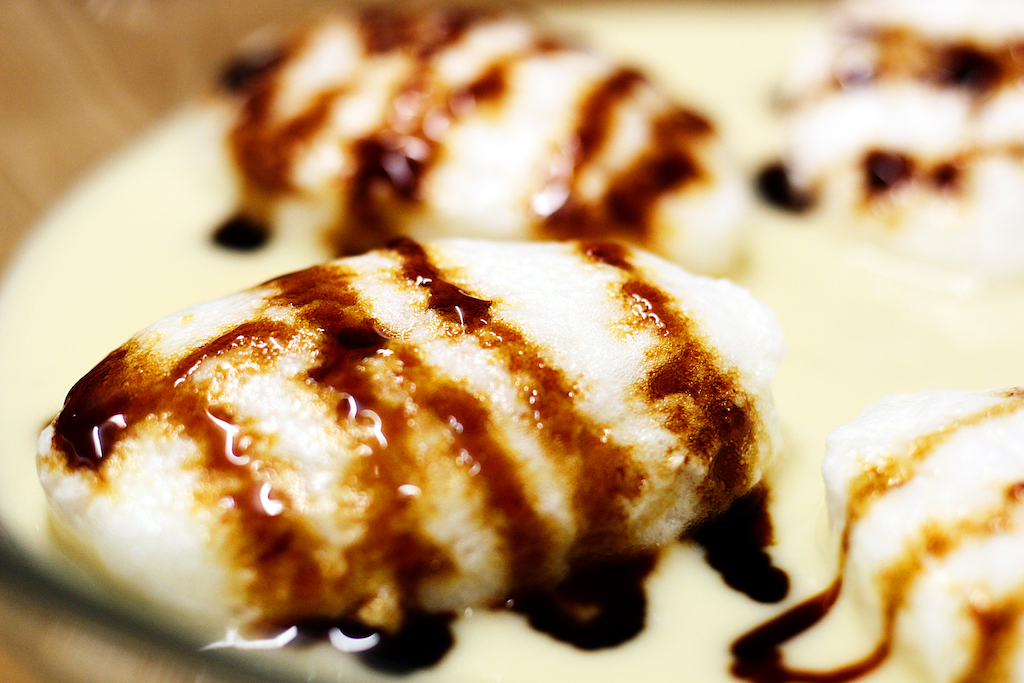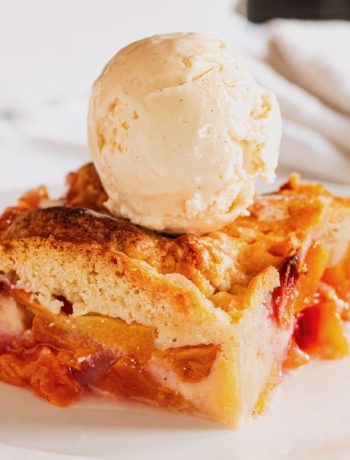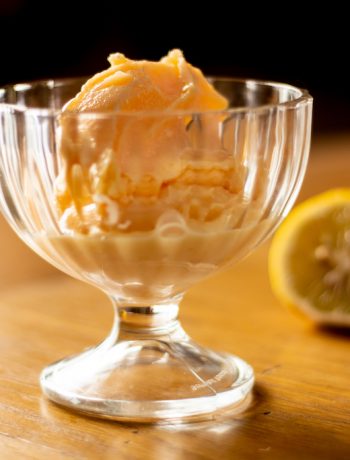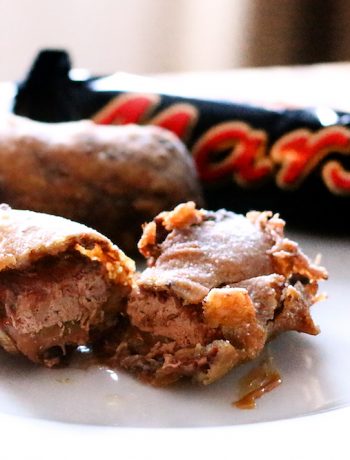I love this dish. To my mind it is quintessentially French, even though it often goes by its English name ‘floating islands’. It is right up there with other great French desserts such as tarte au citron, and it was one of the first things I cooked from my newly purchased copy of Larousse all those years ago.
While the method I have described here is what most cooks would consider to be the contemporary version of îles flottante, older recipes are worth a mention. Historically, îles flottante were made using slices of stale sponge or brioche, soaked in liqueur and spread with jam, served with cold custard and a purée of raspberries or strawberries, sprinkled over with chopped almonds. This sounds a lot like it could be the forerunner of that modern childhood favourite – the trifle. Other than that, there isn’t a huge amount of history behind this dish, although there are a few different variations of both ingredients and cooking methods. Some recipes cook the meringues in a bain marie, whilst for the variation that I have chosen, you can poach them in either milk or water.
Îles flottante are incredibly light, which makes them the perfect way to finish a long meal. You can choose to serve them in individual glass bowls for that wow factor at a dinner party, or as I did here, in a large dish in the centre of the supper table, to be demolished in seconds by hungry children. One of the reasons I think floating islands are so impressive (aside from the sight of fluffy white clouds of soft meringue, drizzled with slightly bitter sweet caramel, and floating on a pool of silky smooth custard) is that there are a number of technical steps that need to be mastered before you get a good result. There are three in total, and each one has its own bottom clenching moment of anticipation, after which you know that you are either going on to the next one, or putting your last effort in the bin and starting again. That said, with a little bit of practice, all steps are relatively easy to master, and you will soon be knocking them out like a pro pâtisserie chef.
Îles flottante
Ingredients
- For the custard and meringues:
- 75ml whole milk
- 1 vanilla pod
- 8 egg whites
- Pinch of salt
- 3 tbsp caster sugar
- 8 egg yolks
- 250g caster sugar
- For the caramel:
- 200g caster sugar
- 180ml cold water
Instructions
Place the milk in a clean, heavy bottomed pan, with the vanilla pod and gently bring to the boil. Remove from the heat and set aside to cool.
Fill a large shallow pan with water and bring to the boil. Once the water is boiling, turn down the heat to a low simmer.
Whisk the egg whites into stiff peaks. This can be done using a food mixer, although I prefer to make meringue by hand, as you have a better 'feel' for when the correct consistency has been achieved. Over beaten egg whites are grainy and will not rise. Either way you must use a scrupulously clean bowl. Once at the desired consistency has been reached, fold in the 3 tbsp of caster sugar.
Either drop spoonfuls of the meringue mixture into the simmering water. Or, if feeling brave, mould into quenelles first. Poach the meringues for 2 minutes, turning half way through. This will ensure that your meringues have a light fluffy texture, whilst being cooked all the way through. Poach for too long and you will end up with something the same consistency as a the white of a poached egg. It will neither float, nor appeal to your dinner guests. This is your first bottom clenching moment. Remove using a slotted spoon and place on a dry clean cloth to drain.
Transfer the vanilla infused milk to a double boiler. Beat the egg yolks with the sugar and add to the milk. If you don't have a double boiler, use a metal bowl placed over a pan of water, ensuring that it doesn't come into contact with the water directly.
Stir continuously over a low heat until the custard begins the thicken. This is clench number two – achieving the correct consistency without over cooking and ending up with a bowl of sweet scrambled egg. The difference between these two is seconds and cannot be reversed. Keep a large basin full of iced water to hand. Once the custard is just thick enough to lightly coat the back of the spoon, plunge the pan into the ice water to cease all further cooking. Egg custard, made in this way bears little resemblance to that from either a tin or a carton. It does not contain cornflour, so is therefore naturally much thinner and lighter. Once cool, chill in the refrigerator.
To make the caramel, place 220g of caster sugar in a clean, dry saucepan. Heat gently, without stirring, until it begins to melt. This is your final bum clench as working with sugar can be tricky. Once it has melted it should be a dark golden to light amber colour. Continue heating until it turns a light mahogany colour. This and the unplatable taste of burnt sugar are only seconds apart. Quickly pour in the cold water. Stir and cook gently for a few more minutes. Set aside until completely cool.
To serve, pour the chilled custard into a large bowl. Pile the poached meringues on top and drizzle with the caramel. Voila!







No Comments